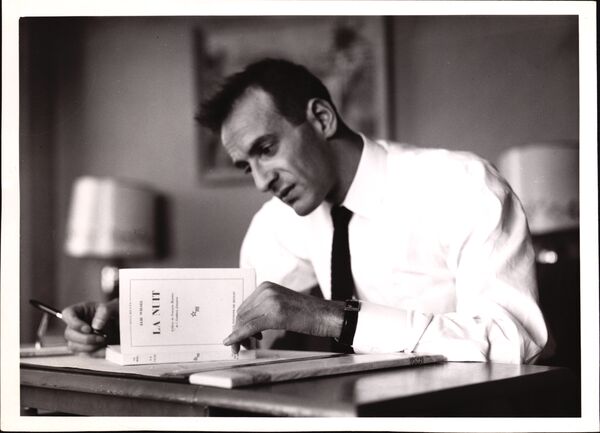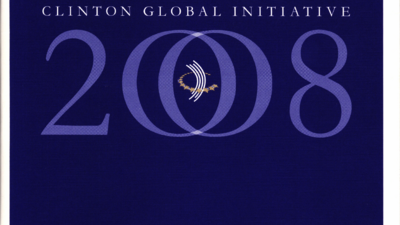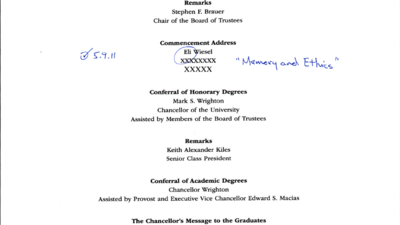Elie Wiesel and La Nuit

Title
Date
Summary
Elie Wiesel, as a young man, signs a copy of his memoir La Nuit, first published in 1958. It is a shortened French version of his Yiddish memoir, Un di velt hot geshvign (And the Word Remained Silent), published in 1955.
More Sources Like This

This document is an invitation and program guide for the Clinton Global Initiative (CGI) Annual Meeting, which took place in New York City from September 24-26, 2008. The invitation letter, dated July 2, 2008, is personally signed by Bill Clinton and addresses Professor Elie Wiesel, inviting him to participate. The meeting aims to convene influential global leaders, including heads of state, business executives, non-profit directors, and faith leaders, to collaborate on actionable solutions for pressing global challenges. Key focus areas highlighted are energy and climate change, poverty alleviation, global health, and education. The document outlines CGI's unique approach, which includes plenary and working group sessions, fostering commitments to action, providing ongoing support, and recognizing achievements. It also lists many prominent individuals who have previously participated in the initiative and details the impressive impact of CGI's efforts in improving lives worldwide. A membership form is included for those wishing to join.

This document is a two-page program detailing the "Order of Exercises" and "Order of Procession" for a commencement ceremony at Washington University, likely held on May 9, 2011. The "Order of Exercises" outlines the various parts of the ceremony, including musical performances ("America the Beautiful" and "Alma Mater"), remarks by Stephen F. Brauer (Chair of the Board of Trustees) and Keith Alexander Kiles (Senior Class President), and the commencement address by Eli Wiesel, titled "Memory and Ethics." It also details the conferral of honorary and academic degrees by Chancellor Mark S. Wrighton. The "Order of Procession" lists the participants in the academic procession, including marshals, the chancellor, the chair of the board of trustees, the faculty senate council chairman, the commencement speaker, student speaker, honorary degree recipients, vocalists, and various other university officials and marshals.
of
Marian Filar
Born December 17, 1917 in Warsaw, Poland, Marian Filar was a member of a musical and religious Jewish family who became a child prodigy and a noted concert pianist and teacher. His father was a manufacturer and his grandfather was a rabbi. He studied at the Warsaw and Lemberg conservatories and graduated from Gymnasium in Warsaw. In September, 1939, he fled to Lemberg following the German invasion. After graduation from the Lemberg Conservatory in December, 1941, he rejoined his family in the Warsaw Ghetto. He worked with a labor group taken outside the ghetto to a railroad workplace in Warsaw West. He describes severe beatings by S.S. guards and his rescue by a Polish railway man. He details his solo performance and other symphony concerts in the ghetto by Jewish musicians, often playing music by forbidden composers. He mentions ghetto deportations, 1942-43, when his parents and siblings were taken.
In May, 1943, after the ghetto uprising, he was deported to Majdanek. After beatings and near-starvation, he volunteered for a labor camp in Skarzysko-Kamiena, where he received aid from a fellow worker who was Polish. Moved to Buchenwald in August 1944, he was housed in a tent camp with Leon Blum, Deladier and other prominent politicians and clerics. Mr. Filar was moved next, by train, to Schlieben, near Leipzig, to work in a bazooka factory, where a Polish kitchen maid gave him extra food. His piano playing impressed the German civilian camp supervisor who transferred him to an easy job to protect his hands. As the war front moved near, he was sent with other prisoners by train to Bautzen and then on a death march to Nicksdorf (Mikulasovice) in Czechoslovakia. He and two brothers survived and lived in Zeilsheim Displaced Person’s camp in Germany for two and a half years.
After liberation, he performed in concerts through Western Europe and toured Israel, playing with the Israeli Philharmonic during the war in 1956. He shares a moving vignette about going to Professor Walter Gieseking’s villa and auditioning to become his student. He studied with him for five years.He emigrated to the USA in 1950, where he played with many American orchestras, headed the piano department at Settlement Music School in Philadelphia, and joined the faculty at Temple University. After retirement, he taught privately and judged international piano competitions.
of
Ephraim Glaser
Ephraim Glaser, born in 1922 in Cluj, Transylvania, Romania, was the son of an orthodox shochet, mohel and chazan. He describes pre-war Cluj and recalls a pogrom that took place in the courtyard of his family’s home when he was five years old.
He describes changes that occurred when the Hungarian occupation began in 1940, including beatings and exclusion of Jews from public schools. He attended cheder and yeshiva until 1943, when he was taken to a forced labor camp. He escaped in 1944, and because of his Aryan appearance and ability to speak German, was able to pose as a Hungarian Christian and join a German army unit as a translator. After several months, suspected of being a Bolshevist, he ran away and found refuge in a factory, whose owner, a baron, hid him in an unused oven.
His sister and her family, hidden in a Czechoslovakian monastery, were deceived by a German promise of safety and returned to their home in August 1941. They were then seized and sent on the last transport to Auschwitz. His brother-in-law, an opera singer and cantor in Bratislava, was shot while singing for the Germans.
Ephraim fled to Miskolc in the Russian zone and was liberated at the end of 1944. He briefly mentions Russian plunder of the local population. After his return to Cluj, he was active in the Zionist underground movement, Bricha2, transporting Jews illegally to Palestine. Accused of being a fascist by former friends who had become Communists, he went to Palestine and worked on a kibbutz in1946. He describes the difficulties encountered among kibbutz members who stigmatized survivors like himself as being cowards who willingly submitted to their own slaughter. That experience caused him to remain silent for many years, not even telling his children about his experiences until later in his life. He explains how his silence and then finally talking about the Holocaust affected his children.
See also Ephraim’s second interview conducted in 1989 during which he discusses more in-depth about his experiences in the German army unit.
Interviewee: GLASER, Ephraim Date: August 10, 1988
of
Sybil A. Niemöeller
Sybil Niemöller (maiden name von Sell) was born in 1923 in Potsdam into an aristocratic Prussian family. Both her grandfathers were Prussian generals. After World War I her father was appointed by Kaiser Wilhelm to be his financial advisor and administrator. She grew up in Berlin-Dahlem where she had several Jewish friends. Her parents were strongly anti-Nazi. The family attended the Confessing Church which was led by their friend Pastor Niemöller. This church was founded as counterpart against the Christian German Church which had embraced Nazi ideology. Because she did not belong to the Hitler Youth she was prevented from graduating from high school and became an actress. During the war her parents sheltered several Jews, disguised as seamstresses and gardeners. Two of her cousins, Werner von Haeften (who was adjutant to Count von Stauffenberg) and Hans Bernd von Haeften were involved in the attempt on Hitler’s life in 1944 and were executed. Both Sybil and her father were also arrested and interrogated at that time, but released. She arrived in the United States in 1952, became a U.S. citizen in 1957, and married Pastor Martin Niemöller. She accompanied him on his lecture tours but made their home in Wiesbaden, Germany. She describes his suffering as “Hitler’s special prisoner” when he was incarcerated in Sachsenhausen and later in Dachau.
Interviewee: NIEMÖLLER, Sybil (von Sell) Date: November 21, 1986
of
Genya Kinegal
Genya Yetz Kinegal, nee Goldfisher was born December 24, 1925 in Skolne, Poland (Galicia), a small village with 3,000 Jews. The town was occupied by Germans in 1939, then by Russians until 1941. Genya briefly describes the Russian Occupation. When the Germans took over, Genya took on a Polish identity and rented an apartment for a time but eventually was captured by the Germans in the fall of 1942, deported to the Przysucha Ghetto, and then to Plaszow where she did forced labor for a year sewing uniforms. In 1943 she was sent to Skarzysko-Kamienna, in Poland where she worked in a munitions factory making launchers for grenades. In August 1944, she was sent in cattle cars to a women’s camp connected to Buchenwald to work in another munitions factory. All the prisoners in these camps were Jews.
Genya describes the daily routine in the camps, hunger, living and working conditions, as well as clandestine attempts to celebrate Jewish holidays. An attempt to save a newborn baby led to dire consequences for all the women in the camp. She explains the “selections” that determined who would live and who would die. The prisoners formed small groups of four or five to support and protect each other.
Genya along with the other prisoners were driven out of the Buchenwald satellite camp in March 1945. They wandered about on foot until they encountered American soldiers on May 5, 1945. The Americans provided food, clothing and shelter. Jewish soldiers obtained certificates that enabled survivors to go to Palestine legally. Genya found out that her entire family perished. She explains how what she went through still affects her psychologically and physically, and how much was taken away from her during the Holocaust.